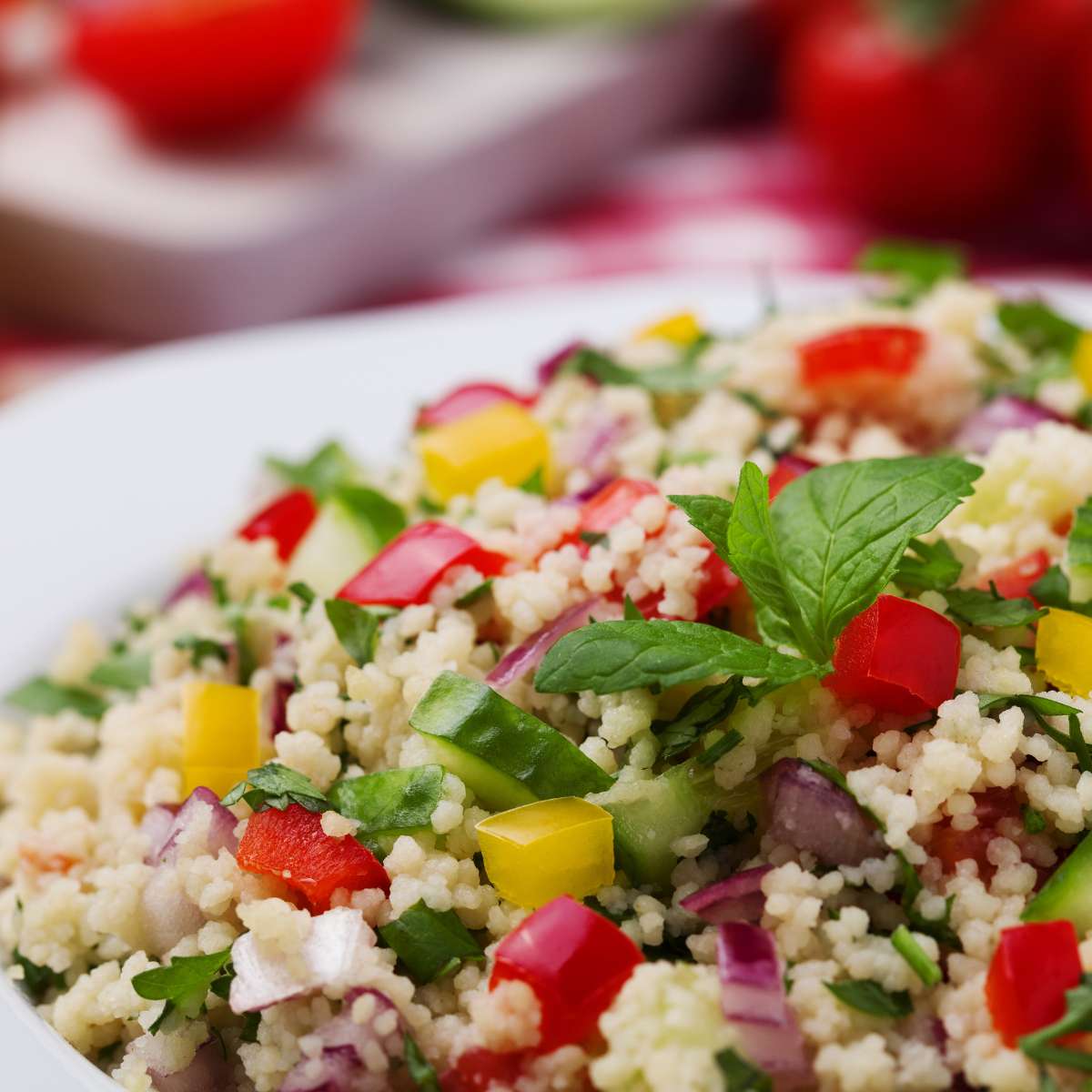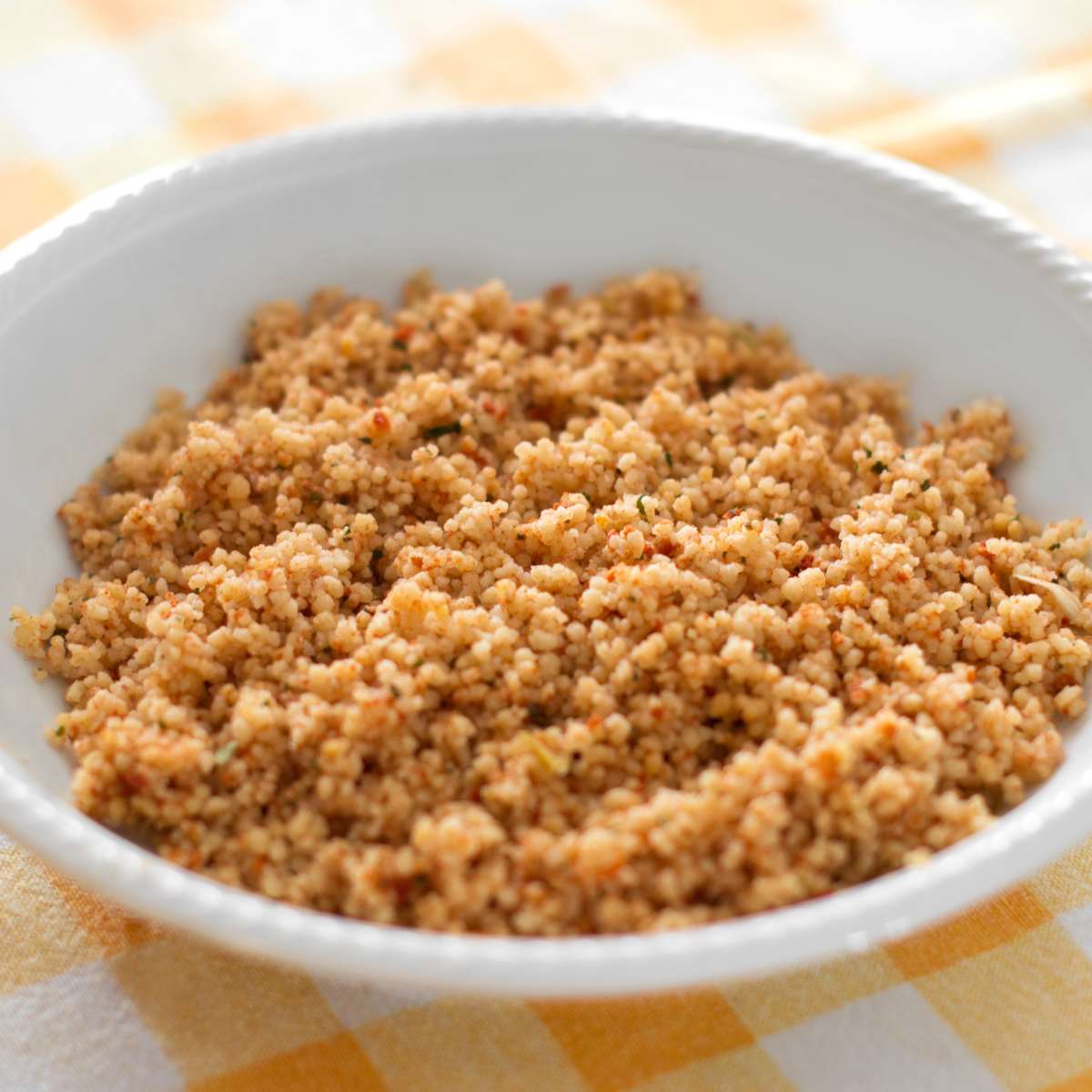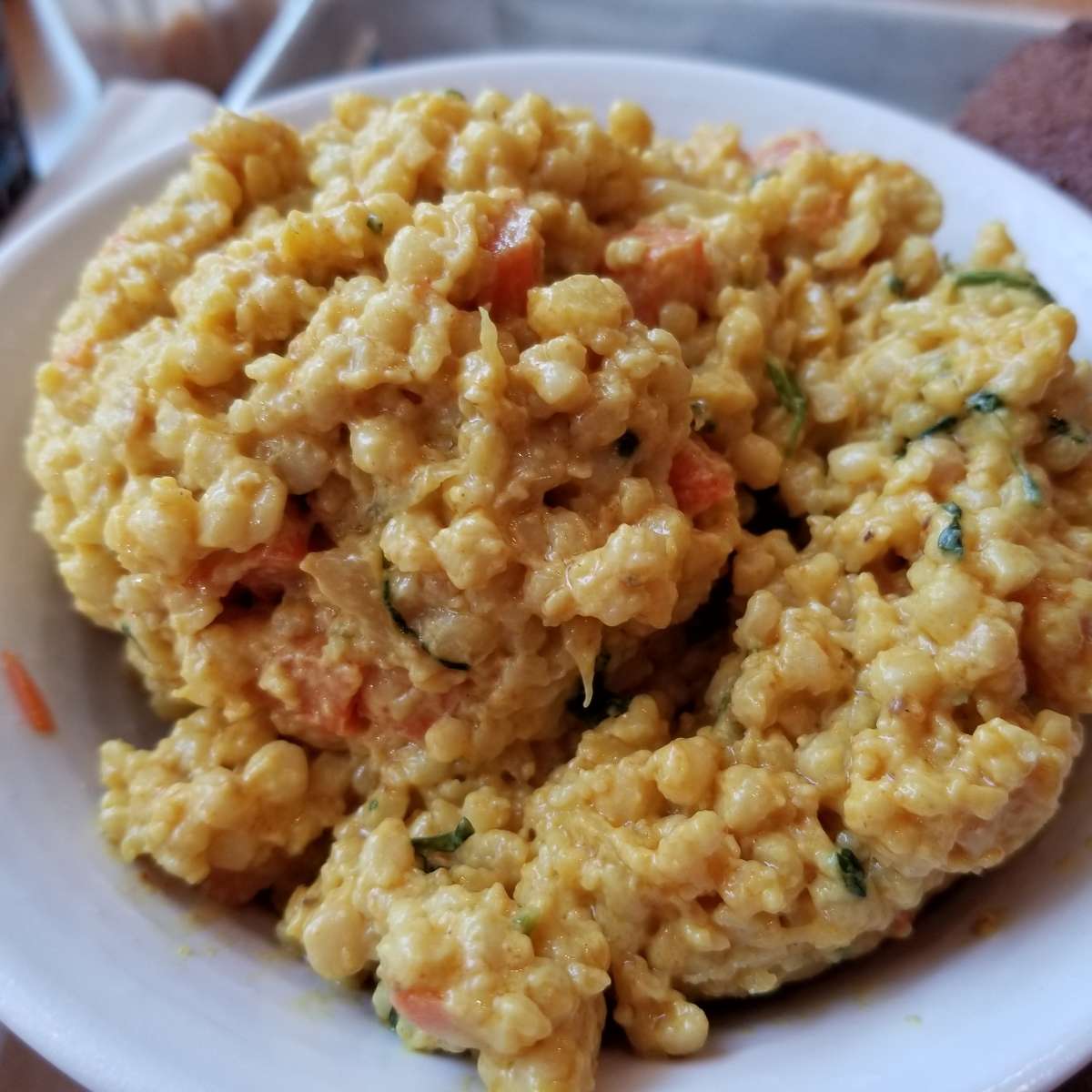What is Cous cous? This isn’t just any old grain; this coarsely ground pasta made from semolina flour is a secret weapon for weeknight dinners and gourmet feasts alike. It’s the culinary buddy that eagerly absorbs flavors, textures, and the love you pour into your dishes.
Ready to become your kitchen’s MVP? Let’s jump into this quick guide and transform your mealtime into a Moroccan-inspired escapade.
👉👉 Related: Lemon pistachio Israeli Coucous recipe
Key Takeaways
- Couscous is a quick-cooking, versatile grain that’s excellent for busy bees looking for flavor without the fuss.
- It stands out as not only a Mediterranean staple but as a culinary chameleon, adapting to any flavor profile you fancy.
- Moroccan markets to your dining table, couscous travels the globe offering a nutritiously rich choice for your recipes.
- Whether you’re a pro at the stove or a novice chef, this guide is your ticket to mastering the simplicity of couscous.
- Embracing whole-wheat couscous means you’re signing up for a high-fiber, high-protein ingredient that’s heart-healthy and satisfying.
- Unlock the potential of this golden grain and let your kitchen adventures lead you down a path of delicious exploration.
History of Couscous
Embark on a historical exploration and let’s dig deep into the origins of your favorite granules of goodness. Discover how couscous history intertwines with the vibrant tapestry of North African cuisine and how the traditional methods of couscous production have evolved over time.
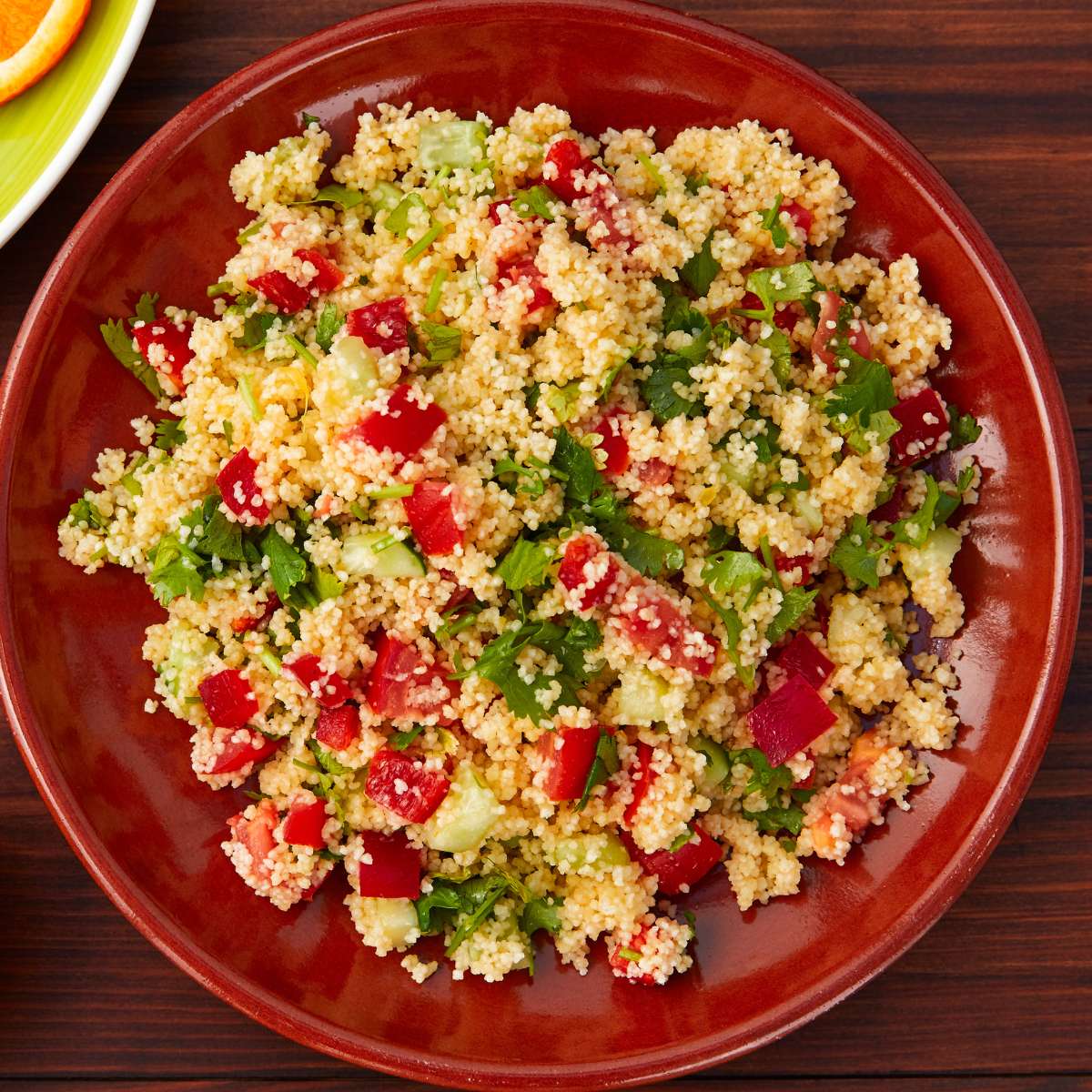
The Berbers’ Culinary Gem
Did you know that couscous proudly traces its lineage back to the Berbers? Indeed, this staple of North African cuisine is the fruit of ancient tradition, a reflection of a land and its people. The term ‘couscous’ itself whispers tales of Berber origins, a homage to the delicacy with which each grain was once ‘well-rolled’ and ‘well-formed’ by hand.
Couscous Across the Mediterranean
As you feast on that fragrant mound of couscous, consider its journey across the Mediterranean Sea. From its Berber roots, this gastronomic gem crossed seas and conquered hearts, finding a home in varied North African kitchens. Now synonymous with the region’s rich culinary legacy, couscous has indeed taken up the mantle as a symbol of Mediterranean opulence.
From Hand-Rolled Traditions to Modern Production
Here’s a snapshot of how couscous production has journeyed from tradition to modernity:
| Aspect | Traditional Production | Modern Production |
|---|---|---|
| Method | Hand-Rolled | Machine-Made |
| Time Taken | Several Hours | Minutes to Hours |
| Main Ingredients | Semolina, Water | Semolina, Water (Sometimes Pre-Cooked) |
| Texture & Flavor | Distinctly Individual Grains, Rich Flavor | Often Uniform in Size, Milder Flavor |
| Cultural Significance | Ceremonial and Tradition-Laden | Convenience-Oriented |
Take pleasure in knowing that when you dine on couscous, you are savoring a dish steeped in history—an edible testament to human creativity and cultural evolution.
The Anatomy of Couscous: Understanding the Grain
Hey there, food explorer! Before we dive deeper, let’s clear the air: couscous might look like a grain, but it’s more of a undercover pasta, slyly fitting in with its whole grain pals. Crafted from durum wheat semolina, this Mediterranean marvel brings a unique twist to the table.
Distinguishing Couscous from Other Grains
It’s easy to get tripped up by couscous, mistaking it for its grainy lookalikes. However, couscous stands out with its signature texture – a testament to its humble beginnings as semolina flour. Thanks to this, it absorbs flavors like a dream, making it a favorite in the diverse Mediterranean diet. it is light and fluffy, unlike other grains such as risotto, which is an Italian grain that is creamier and looks more like rice.
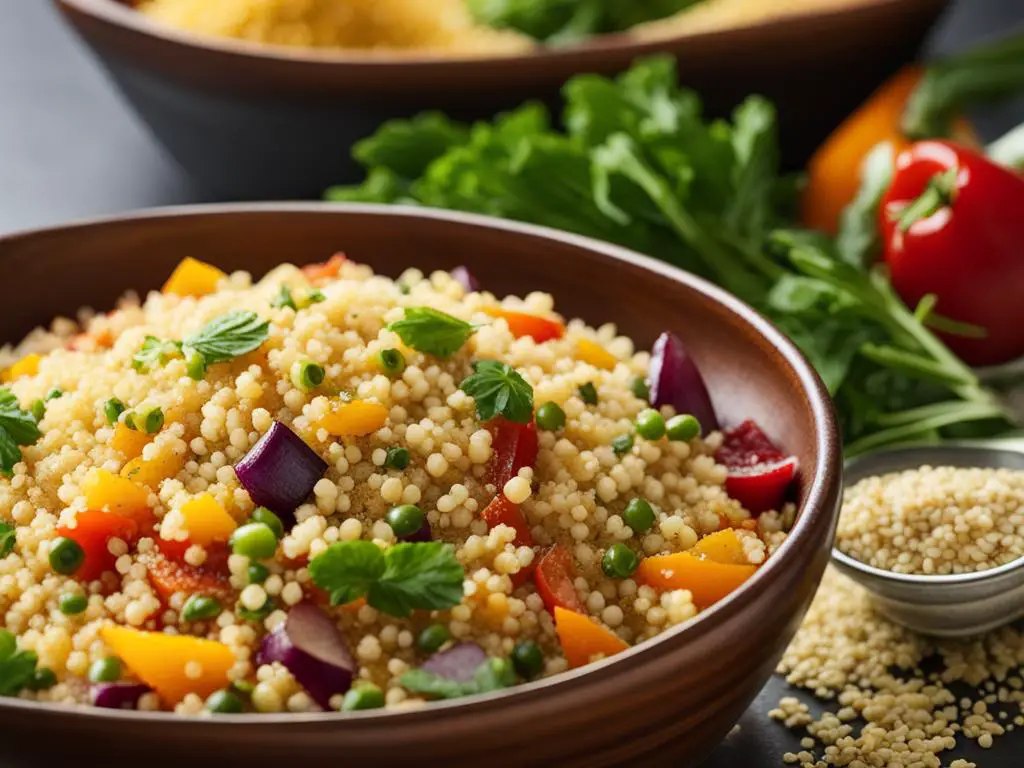
So, next time you’re navigating the grain aisle, remember that couscous is the pasta in disguise.
Anatomy of a Couscous Grain: Nutritional Overview
Let’s put on our nutritionist glasses and take a closer look at what makes couscous tick. If you’re gunning for health, reach for the whole-wheat couscous – the Whole Grains Council couldn’t stop raving about its nutritional punch.
Packed with protein, fiber, and a sidekick of essential nutrients, it’s gunning to become a staple in your wholesome diet. Check out this handy table for the scoop on its nutritional merits:
| Nutrient | Benefit | Whole-Wheat Couscous |
|---|---|---|
| Protein | Builds muscle, satisfies hunger | Rich in plant-based protein |
| Fiber | Improves digestion, maintains blood sugar levels | Higher fiber content than refined |
| Complex Carbohydrates | Provides sustained energy | Integral for energy provision |
| Minimal Sodium | Supports heart health | Keeps your heart ticking nicely |
| Vitamins & Minerals | Enhances overall health | Fortified with extra goodness |
There you have it – couscous is not only a culinary chameleon but also a nutrition ninja, ready to blend into your balanced diet while packing a hearty health punch. So go on, make that couscous tabbouleh, and feel good about the fuel you’re giving your body.
Couscous Varieties: Exploring the Types and Their Uses
Now, let’s wade into the diverse and flavorful world of couscous, where size truly does matter — and so does the grain. Embark on a taste adventure as you discover the unique characteristics of Moroccan couscous, savor the chewy generosity of pearl couscous, and relish the distinctiveness of Lebanese couscous.
Here’s a hint: while they may share a familial name, their culinary applications vary as widely as the landscapes of their homelands.
Moroccan, Pearl, and Lebanese Couscous – A Comparison
- Moroccan Couscous: The speedster of the group, cooking up in a flash to deliver a fine, fluffy texture that partners well with stews and veggies.
- Pearl Couscous: Known to some as Israeli couscous, these plump pearls bring a playful bite to the palate and a visual pop to your plate in risotto-esque dishes.
- Lebanese Couscous: Sizeable and satisfying, these substantial grains demand a more patient simmer, perfect for absorbing the complex flavors of your favorite broths.
- Try out our Lemon Pistachio Israeli coucous recipe and surprise your taste buds!
And just when you thought couscous couldn’t get better, whole-wheat varieties strut onto the scene, flexing their nutritional muscle. But why opt for these wholesome morsels? Let’s dig in.
Why Whole-Wheat Couscous Reigns Superior
Calling all health mavens and fiber fans! If you’re looking to add a nutritious punch to your culinary creations, whole-wheat couscous is your go-to grain.
Packed with all the bountiful benefits of the whole grain, namely the endosperm, the germ, and the bran, it delivers not just a rustic, nutty flavor but a trove of whole-wheat couscous benefits. We’re talking heart health, digestion, and a happy conscience knowing you’re honoring your body with every bite.
While the charms of each type of couscous are undeniable, remember that choosing between Moroccan, pearl, or Lebanese varieties isn’t just a matter of taste—it’s about finding the perfect grain for your plate’s landscape. Whole-wheat couscous, with its nutritional accolades, stakes its claim as the crowning glory of health-conscious foodies.
Now, go forth and let your culinary flag fly high with these delectable grains!
Cooking Couscous: A Step-by-Step Guide
So, you’ve decided to dive into the world of couscous preparation, eh? Congratulations! This deceptively simple meal is about to become your new best friend. And no, you don’t need a magic lamp to make it happen, just a 1:1 ratio of liquid to couscous magic.
But before you start, remember, your couscous is shy – no rinsing or soaking necessary. It’s ready to puff up the second it hits the hot liquid.
Foolproof Cooking Ratios and Techniques
One cup of the golden grains to one cup of boiling liquid is the secret incantation for perfect couscous. But here’s where you get to direct your culinary destiny. Want your couscous to be the life of the party and mingle freely?
Go easy on the liquid, and you’ll have grains so light and flaky, you’ll be watching them dance on your plate. Or perhaps you prefer your couscous a bit clingy? Then don’t shy away from a little extra liquid for a stickier companion to your saucy dishes.
Maximizing Flavor: To Toast or Not to Toast?
Toasting your couscous isn’t just about showing off your fancy skillet moves. It’s about infusing those tiny orbs with a flavor so nutty, you’d think they cracked a joke. A smidgen of oil and a medium heat is the stage for your couscous’s flavor transformation.
But beware, introducing water during this pivotal toasting performance is a no-no. Patience, young grasshopper, for adding water too early is the natural enemy of that gloriously rich texture you seek in your grain recipes.
There you have it! With these tips under your chef’s hat, your cooking couscous adventure is bound to be a success. So whip out that pot, and let’s get this culinary show on the road! And remember, whether you toast or not, each tiny grain of couscous is your canvas, ready to embrace the flavors of your choosing.
What is Couscous: Beyond the Basics
You might think you know couscous, but the journey is just beginning. As a couscous staple in Mediterranean cuisine, its mastery in multifaceted dishes is akin to a chameleon’s ability to blend with its surroundings. Let’s delve deeper than ever before into the compelling world of couscous and unearth the couscous benefits that make it an evergreen presence in our kitchens.
Here’s a thought: why settle for the mundane when couscous is in town? Transform the familiar into the extraordinary. Picture it as the centerpiece in a vibrant salad, or imagine it as the comforting foundation of a slow-cooked stew. The versatility of couscous is your culinary passport to a world of flavor without leaving your dining table.
- Firing up the grill? Toss couscous in a salad with grilled vegetables for a smoky, savory punch.
- Feeling exotic? Let couscous channel the aromatic spices of a Moroccan tagine, absorbing the fragrances and tastes of the Sahara.
- Craving simplicity? Serve it plainly buttered as a humble companion to a stew or roasted meats.
Embrace couscous year-round – it’s not just a summer fling but a winter comfort, too. It’s the friend who brings the bottle of sunshine to your heartiest of meals, and the comfort when the leaves start to turn. It’s time to redefine the role of couscous in your recipe repertoire, and here’s your chance to start.
Remember, with couscous, you’re not just cooking; you’re curating a globe-trotting menu from the comfort of your own kitchen.
Inspiring Ideas to Serve and Pair Couscous
Let couscous be your blank canvas as you embrace the art of food pairing and plating. A staple in Mediterranean dishes, couscous is no underdog when it comes to heart-healthy meals. Imagine a bowl filled with vibrant hues and textures, and you’ve just envisioned the potential of couscous salads. But wait, there’s more to couscous than meets the eye!
Refreshing Salads and Hearty Mains
Whether you’re looking to whip up a quick, refreshing lunch or a substantial dinner, couscous salads are a breeze to concoct. It’s the dynamo of the dining table, ready to be transformed by a medley of fresh ingredients.
Dive into a summery Mediterranean fantasy with a spinach, cherry tomato, and feta couscous salad, drizzled with a light lemon vinaigrette. When the cooler months roll in, bulk it up into a hearty main—think roasted root vegetables mingling with warm couscous, enlivened by a sprinkle of cumin and coriander.
Adaptable Add-Ins: From Herbs to Proteins
Your quest for customizable couscous recipes ends right on your kitchen counter. The adaptability of couscous is akin to an artist’s palette—ready to blend with a spectrum of add-ins. Go green with a mix of basil, parsley, and mint for a herbaceous punch.
For protein lovers, couscous cozies up beautifully with grilled chicken, flaky salmon, or marinated tofu. The result? A sensational dish that whispers (or shouts, if you prefer bolder flavors) the essence of the Mediterranean.
| Ingredient Type | Ingredient Suggestions | Perfect For |
|---|---|---|
| Vegetables | Artichokes, red peppers, olives | Moroccan-inspired couscous |
| Herbs | Cilantro, mint, dill | Refreshing couscous tabbouleh |
| Proteins | Grilled shrimp, lamb meatballs, chickpeas | Filling couscous bowls |
| Cheese | Feta, goat cheese, Parmesan | Luscious couscous risottos |
| Nuts | Almonds, pine nuts, pistachios | Crunchy couscous pilafs |
So, there you have it—your guide to making couscous the star of your next meal. Play with flavors, colors, and textures, letting this versatile grain take your taste buds on a journey through the sun-drenched shores of the Mediterranean.
Transform Your Favorites: Couscous in World Cuisines
As you embark on a culinary escapade, embrace the couscous versatility that lets you traverse world cuisines without leaving your kitchen. Imagine transforming traditional staples into international dishes with a sprinkle of couscous magic. Curious how? Let’s dive into the global escapades of this tiny yet mighty grain.
Couscous Meets Italian Culinary Flavours
Believe it or not, couscous is not playing hide-and-seek in the shadow of pasta. Oh no, it revels in the spotlight of Italian cuisine, boldly substituting spaghetti or fettuccine when the pantry calls for a twist.
Splashed with a hearty marinara or pesto, couscous effortlessly absorbs every note of basil, garlic, and sun-ripened tomatoes, leaving you shouting “Mamma mia!” with delight.
A Medley of Global Inspirations with Couscous
Who says couscous can’t flirt with the exotic spices of the East or sashay through the vivacious veggie markets of the Mediterranean? It’s a cosmopolitan ingredient, a dining passport granting you access to a world of flavors. See the table below for a tantalizing glimpse into the couscous fusions from various cuisines:
| Cuisine | Dish | Couscous Role |
|---|---|---|
| Middle Eastern | Tagine | Base for saucy, spiced brilliance |
| European | Stuffed Peppers | Hearty filling paired with bold flavors |
| Asian | Curry Couscous Bowl | Grain substitute sopping up luscious curry |
Now, with inspiration dotting every inch of the globe, you’re well-equipped to turn any meal into a couscous-centric feast. Whether it’s a comforting bowl on a chilly evening or a zesty salad under a sunny sky, allow couscous – that ambassador of grains – to guide you through an illustrious tapestry of world cuisines.
Storing and Reheating: Keeping Couscous Fresh
Ever find yourself stashing away surplus couscous, only to ponder on its shelf life? Fret not. When it comes to food storage, couscous is pretty low maintenance, and knowing how to keep it fresh can be a game changer for your meal prep routine.
Packed with the art of food preservation, an airtight container is your knight in shining armor, locking in the freshness for up to a succulent four days in the chilly confines of your fridge.
What about a quick couscous encore? Ah, the magic of reheating couscous lies in its simplicity. Want to bring those grains back to life? Just a splash of water—or for the daring, a hint of chicken stock—and a swift warm-up in your saucepan can transform yesterday’s side dish into today’s star.
And if the freezer is your foodie photo album, snap a shot of couscous for a nostalgic nosh months later. Just be sure to thaw with the tenderness of a food lover’s touch.
- Store in an airtight container in the fridge for utmost freshness
- Add a little water and reheat in a saucepan to revisit peak tastiness
- Freeze for future feasting, and thaw with care when craving strikes
And who would’ve thought? Your couscous is not only a mealtime virtuoso but a master of longevity. Here’s to keeping that versatile grain not just edible but delectable, always ready for its next kitchen cameo.
Conclusion
Embarking on a culinary exploration with couscous has revealed a galaxy of flavors that orbit around this Mediterranean marvel. It’s the daredevil in your pantry that leaps at the chance to partner up with any ingredient that dares cross its path.
With each season that passes, couscous remains your steadfast companion, ready to spring into action whether the calendar says salads or soups. A plate adorned with couscous is a testament to your creative cooking, proving that a single ingredient can become the cornerstone of year-round innovations.
Your Pantry Staple: Year-Round Versatility
Imagine a pantry without the golden versatility of couscous – it’d be like a painter without a canvas. As you’ve uncovered throughout this guide, from its noteworthy nutrition to its breezy preparation, couscous is the quintessential year-round ingredient.
It adapts without fuss, serving your springtime zests, your summer tangs, your autumnal spices, and your wintry warmth with nonchalant grace. It’s the low maintenance, high reward kind of staple that makes every meal an opportunity for new discoveries.
Unleashing Creativity with Couscous
Don your culinary cape and forge ahead into a realm where couscous becomes the muse to your kitchen artistry. There’s never a dull moment when you allow this versatile grain to inundate itself with the aromatic whispers of your spice cabinet or the bright notes of your herb garden.
It’s not just about tossing ingredients together; it’s about witnessing the alchemy of flavors when couscous takes the stage. Let it inspire you, let it challenge you, and let it remind you that the best dishes aren’t just cooked – they’re crafted with innovation and a dash of daring.
FAQ
What exactly is couscous, and how does it fit into my culinary adventures?
Think of couscous as the golden child of the Mediterranean pantry. It’s not a grain, but a coarsely ground pasta made from semolina flour. Quick to cook, a breeze to flavor, and a chameleon in the kitchen, couscous is your ticket to a hassle-free culinary expedition.
Could you whisk me through the savory story behind couscous?
Absolutely! Born from the skilled hands of the Berbers, this North African marvel reflects a rich history. From local Moroccan souks to your very dish, couscous carries the legacy of tradition in every well-rolled bite. Indulge in this Mediterranean staple and you’re savoring centuries of culture.
What makes couscous nutritionally noteworthy?
Couscous isn’t just a pretty face in the culinary crowd; it’s packed with perks. Whole-wheat couscous, in particular, boasts protein and fiber, playing right into the heart of a balanced Mediterranean diet. It’s like the nutritious backbone to your delicious grain recipes.
Is there more than one type of couscous? And if so, why choose whole-wheat?
Oh, the world of couscous is a cornucopia of types! From the fine sands of Moroccan couscous to the pearl-like Israeli version, and the Lebanese variant in between, variety is the spice of life here. Whole-wheat couscous, however, wears the whole-grain crown for its nutrient density, making it a health-conscious choice.
Do you have any tips for cooking couscous?
For the perfect fluff, stick to a 1-to-1 ratio of liquid to couscous. To enhance its nutty undertones, toast it lightly in oil before adding water. And remember, patience is not necessary—the magic happens in a matter of minutes with this speedy Mediterranean wonder.
How can couscous elevate my usual dishes?
Check this out: couscous can morph faster than a fashionista. Slide it into salads for a refreshing twist or let it be the star of your hearty mains. It lovingly locks in the flavors of herbs, takes to proteins like a dream, and can make your Mediterranean dishes sing.
Can I take my taste buds around the world with couscous?
For sure! Don your culinary explorer hat because couscous will be your trusty companion from the zest of Middle Eastern dishes to the allure of Italian kitchens. It’s a unifying base for a smorgasbord of international recipes. Embrace couscous fusion and become a global gastronome!
What’s the best way to store and reheat couscous to keep it fresh?
You’ve got options. Tuck it away in an airtight container in the fridge, and it stays perky for up to four days. When you’re ready to rekindle your flame with couscous, just introduce a drizzle of water in a saucepan, and voilà! It’s like yesterday’s culinary romance brought back to life.
Can I use couscous for creative cooking all year round?
Heck yes! Whether winter, spring, summer, or fall, couscous is your go-to canvas for creativity. Play with spices and textures, let it mingle with summer veggies, or cozy up with it in a winter stew. Year-round versatility? Couscous has it in spades.

